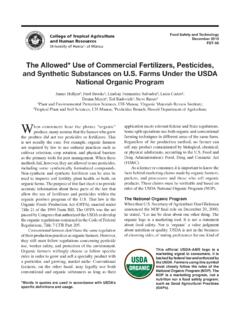Transcription of Use of biotechnology in agriculture--benefits and risks
1 biotechnology May 2003 (revised) BIO-3 Use of biotechnology in agriculture benefits and risks Ania Wieczorek Department of Tropical Plant and Soil Sciences What is biotechnology , and how is it used in agriculture ? biotechnology is the application of scientific techniques to modify and improve plants, animals, and microor ganisms to enhance their value. Agricultural biotech nology is the area of biotechnology involving applica tions to agriculture . Agricultural biotechnology has been practiced for a long time, as people have sought to im prove agriculturally important organisms by selection and breeding.
2 An example of traditional agricultural bio technology is the development of disease- resistant wheat varieties by cross-breeding different wheat types until the desired disease resistance was present in a resulting new variety. In the 1970s, advances in the field of molecular biol ogy provided scientists with the ability to manipulate DNA the chemical building blocks that specify the char acteristics of living organisms at the molecular level. This technology is called genetic engineering. It also al lows transfer of DNA between more distantly related or ganisms than was possible with traditional breeding tech niques.
3 Today, this technology has reached a stage where scientists can take one or more specific genes from nearly any organism, including plants, animals, bacteria, or vi ruses, and introduce those genes into another organism. An organism that has been transformed using genetic engineering techniques is referred to as a transgenic or ganism, or a genetically engineered organism. Many other terms are in popular use to describe these aspects of today s biotechnology . The term genetically modified organism or GMO is widely used, although genetic modification has been around for hundreds if not thousands of years, since deliberate crosses of one variety or breed with another result in offspring that are genetically modified compared to the parents.
4 Similarly, foods derived from transgenic plants have been called GMO foods, GMPs (genetically modified products), and biotech foods. While some refer to foods devel oped from genetic engineering technology as biotech nology-enhanced foods, others call them frankenfoods. For the reasons discussed later in this publication, controversy affects various issues related to the growing of genetically engineered organisms and their use as foods and feeds. How does genetic engineering differ from traditional biotechnology ?
5 In traditional breeding, crosses are made in a relatively uncontrolled manner. The breeder chooses the parents to cross, but at the genetic level, the results are unpredict able. DNA from the parents recombines randomly, and desirable traits such as pest resistance are bundled with undesirable traits, such as lower yield or poor quality. Traditional breeding programs are time-consuming and labor-intensive. A great deal of effort is required to separate undesirable from desirable traits, and this is not always economically practical.
6 For example, plants must be back-crossed again and again over many growing seasons to breed out undesirable characteristics produced by random mixing of genomes. Current genetic engineering techniques allow seg ments of DNA that code genes for a specific character istic to be selected and individually recombined in the new organism. Once the code of the gene that deter-Published by the College of Tropical agriculture and Human Resources (CTAHR) and issued in furtherance of Cooperative Extension work, Acts of May 8 and June 30, 1914, in cooperation with the Department of agriculture .
7 Andrew G. Hashimoto, Director/Dean, Cooperative Extension Service/CTAHR, University of Hawaii at Manoa, Honolulu, Hawaii 96822. An Equal Opportunity / Affirmative Action Institution providing programs and services to the people of Hawaii without regard to race, sex, age, religion, color, national origin, ancestry, disability, marital status, arrest and court record, sexual orientation, or veteran status. CTAHR publications can be found on the Web site < > or ordered by calling 808-956-7046 or sending e-mail to BIO- 3 Use of biotechnology in agriculture benefits and risks CTAHR May 2003 mines the desirable trait is identified, it can be selected and transferred.
8 Similarly, genes that code for unwanted traits can be removed. Through this technology, changes in a desirable variety may be achieved more rapidly than with traditional breeding techniques. The presence of the desired gene controlling the trait can be tested for at any stage of growth, such as in small seedlings in a green house tray. The precision and versatility of today s bio technology enable improvements in food quality and production to take place more rapidly than when using traditional breeding. Transgenic crops on the market Although genetically engineered organisms in agricul ture have been available for only 10 years, their com mercial use has expanded rapidly.
9 Recent estimates are that more than 60 70 percent of food products on store shelves may contain at least a small quantity of crops produced with these new techniques. Major crop plants produced by genetic engineering techniques have been so welcomed by farmers that cur rently a third of the corn and about three-quarters of the soybean and cotton grown in the USA are varieties de veloped through genetic engineering (see http://usda. ). Twelve transgenic crops (corn, tomato, soybean, cotton, potato, rapeseed [canola], squash, beets, papaya, rice, flax, and chicory) have been approved for commercial production in the USA.
10 The most widely grown are Bt corn and cotton and glyphosate-resis tant soybeans. Bt corn and cotton have had DNA from a naturally occurring insecticidal organism, Bacillus thurin-giensis, incorporated into their genome; it kills some of the most serious insect pests of these crops (Eu ropean and southwestern corn borers, and cotton bud worms and bollworms) after they feed on the plant, while beneficial insects are left unaffected. Glyphosate-resis tant soybeans are unharmed by the broad-spectrum her bicide glyphosate, a characteristic that allows farmers to kill yield-reducing weeds in soybean fields without harming the crop.










